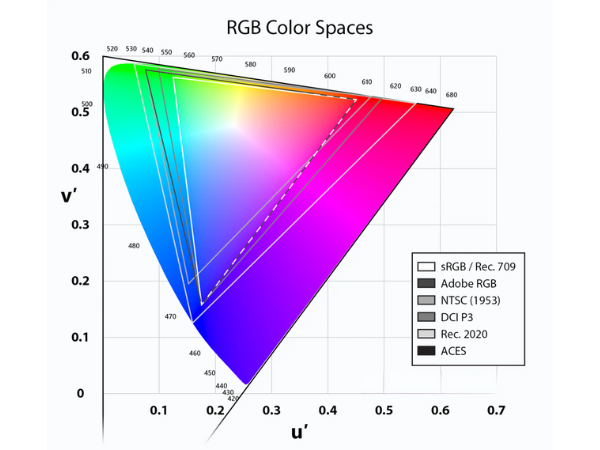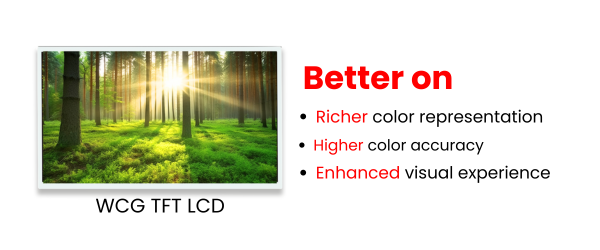Was ist ein Wide Color Gamut TFT LCD?
Zeit:2024-09-24
Ansichten:234
I. What is Color Gamut?
Color gamut refers to the range of colors a device or system can display. A wider color gamut allows for richer and more diverse color expression in images. Understanding color gamut is crucial for selecting the right display technology.
In simpler terms, color gamut is the spectrum of colors your device can show.
II. The Origin of Color Gamut
In 1931, the CIE International Lighting Association introduced the CIE-XYZ color gamut chromaticity diagram. Here, the x-axis represents red, the y-axis green, while blue can be derived from (1-xy). The E point signifies white light at coordinates (0.333, 0.333). Colors at the edges are spectral colors, with boundary numbers indicating their wavelengths. All visible colors lie within this defined space.
III. Common Color Gamut Standards
Common standards include NTSC, sRGB, Adobe RGB, and DCI-P3:
● NTSC: The color space for NTSC television, widely used in the TV industry.
● sRGB: Developed by the International Electrotechnical Commission (IEC), covering about 35% of human-visible colors, ideal for monitors and printers.
● Adobe RGB: Offers a broader range of greens and blues, suitable for professional photography and print work.
● DCI-P3: Primarily for film production, this standard displays richer reds and greens, vital for modern monitors and TVs.

IV. The Color Gamut of Monitors
A monitor‘s color gamut indicates the range of colors it can display, expressed as a percentage of a standard. For example, a monitor with 100% sRGB coverage can show all colors defined in the RGB spectrum. Advances in display technology have expanded color gamut capabilities, enhancing user experience in image and video viewing. High gamut monitors utilize advanced technologies like LED backlighting, quantum dots, and OLED panels to improve color performance, particularly in vibrant hues.
V. Benefits of High Color Gamut
High color gamut offers significant advantages. For professionals like photographers and designers, it ensures accurate color reproduction, enhancing post-processing accuracy. For casual users, high gamut monitors deliver a more vibrant visual experience, especially for High Dynamic Range (HDR) content. As user demands for electronic products rise, high color gamut displays will increasingly become the norm.

Q&A
1. How to Choose a LCD Screen by Color Gamut?
● Adobe RGB: Ideal for professionals in retouching, video editing, and publishing.
● sRGB: Suitable for general office use and web browsing.
● NTSC: Useful for those in the broadcast and film industries. In the LCD industry, the NTSC color gamut standard is usually used as a benchmark.
● DCI-P3: Best for film and television professionals.
2. Factors affecting LCD color gamut value?
The color filter used in the LCD and the backlight design are primary factors.
3. What Constitutes a High Color Gamut?
Generally speaking, a LCD screen with a color gamut coverage of 90% AdobeRGB or 90% NTSC or more is called a high gamut screen. Professional-grade monitors aimed at designers can reach 100% AdobeRGB color gamut, while high-end design monitors and gaming monitors positioned at the top end of the market can reach a color gamut of 90% AdobeRGB or 90% NTSC or more, and better monitors can reach a color gamut of 100% sRGB or 72% NTSC or more.
The above is MAXEN‘s sharing on the concept of color gamut. We hope it helps readers understand the importance of "color gamut" in LCD monitors and how to choose the right display. MAXEN‘s high color gamut LCD screens can achieve up to 95% NTSC coverage. Feel free to reach out for more information!


